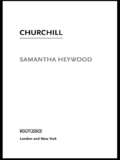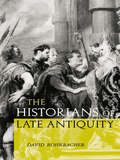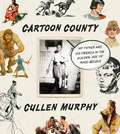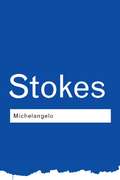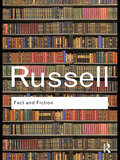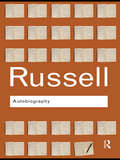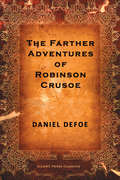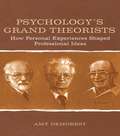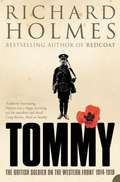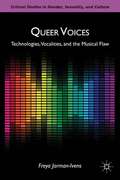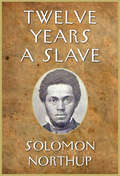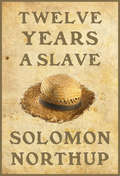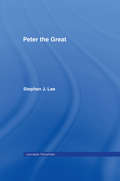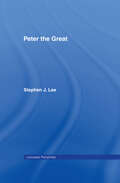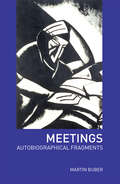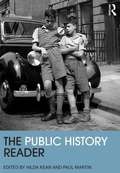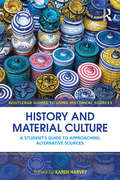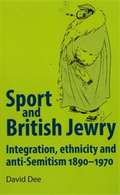- Table View
- List View
Churchill
by Samantha HeywoodChurchill examines the influential career of Winston Churchill, British Prime Minster during the Second World War and from 1951–55. It discusses his early career as Secretary of State for War and Air and Chancellor of the Exchequer, Churchill as Warlord, and Churchill in opposition and the 1951 government. The book examines a wide variety of sources from contemporary newspaper accounts to Churchill's letters to his wife.
The Historians of Late Antiquity
by David RohrbacherThe fourth and fifth centuries AD were an era of religious conflict, political change and military conflict. The responses of contemporary historians to these turbulent times reflect their diverse backgrounds - Christian and pagan, writing in both Greek and Latin, documenting church and state.This volume is the first to offer an accessible survey of the lives and works of these varied figures. The first half of the book explores the structure, style, purpose and nature of their writings. The second half compares and contrasts the information the historians provide, and the views they express on some central topics. These range from historiography, government and religion to barbarian invasions, and the controversial emperors Julian 'The Apostate' and Theodosius.
The Historians of Late Antiquity
by David RohrbacherThe fourth and fifth centuries AD were an era of religious conflict, political change and military conflict. The responses of contemporary historians to these turbulent times reflect their diverse backgrounds - Christian and pagan, writing in both Greek and Latin, documenting church and state.This volume is the first to offer an accessible survey of the lives and works of these varied figures. The first half of the book explores the structure, style, purpose and nature of their writings. The second half compares and contrasts the information the historians provide, and the views they express on some central topics. These range from historiography, government and religion to barbarian invasions, and the controversial emperors Julian 'The Apostate' and Theodosius.
Cartoon County: My Father And His Friends In The Golden Age Of Make-believe (PDF) (400MB+)
by Cullen MurphyFor a period of about fifty years, right in the middle of the American Century, many of the the nation's top comic-strip cartoonists, gag cartoonists, and magazine illustrators lived within a stone's throw of one another in the southwestern corner of Connecticut-a bit of bohemia in the middle of those men in their gray flannel suits. Cullen Murphy's father, John Cullen Murphy, drew the wildly popular comic strips Prince Valiant and Big Ben Bolt, and was at the heart of this artistic milieu. Comic strips and gag cartoons read by hundreds of millions were created in this tight-knit group- Superman, Beetle Bailey, Snuffy Smith, Rip Kirby, Hagar the Horrible, Hi and Lois, Nancy, Sam & Silo, Amy, The Wizard of Id, The Heart of Juliet Jones, Family Circus, Joe Palooka, and The Lockhorns, among others. Cartoonists and their art were a pop-cultural force in a way that few today remember. Anarchic and deeply creative, the cartoonists were independent spirits whose artistic talents had mainly been forged during service in World War II. Illustrated with never-before-seen photographs, cartoons, and drawings, Cartoon County brings the postwar American era alive, told through the relationship of a son to his father, an extraordinarily talented and generous man who had been trained by Norman Rockwell. Cartoon County gives us a glimpse into a very special community-and of an America that used to be.
Michelangelo
by Adrian StokesAdrian Stokes was one of the twentieth century's finest and most discriminating writers on art. Of over twenty works of art criticism, Michelangelo was considered by Lawrence Gowing to be the most complete he ever wrote, presenting an understanding of the great artist that no one subsequently could afford to ignore. Stokes brings to bear in this work not only twenty-five years' study and appreciation of Italian Renaissance art and of aesthetics, but also a unique psychological perspective, as he explains in his introduction, which enables him to uncover the depths of the artist's personality. The subtlety of feeling and profound knowledge of sculpture which Sir Herbert Read admired in Stokes's work is also combined with a literary style perfected through his own poetry and criticism. Presenting a unique survey of his subject's literary as well as his artistic legacy, Stokes succeeds, as no other has before or since, in his aim of bringing Michelangelo's greatness into nearer view.
Michelangelo
by Adrian StokesAdrian Stokes was one of the twentieth century's finest and most discriminating writers on art. Of over twenty works of art criticism, Michelangelo was considered by Lawrence Gowing to be the most complete he ever wrote, presenting an understanding of the great artist that no one subsequently could afford to ignore. Stokes brings to bear in this work not only twenty-five years' study and appreciation of Italian Renaissance art and of aesthetics, but also a unique psychological perspective, as he explains in his introduction, which enables him to uncover the depths of the artist's personality. The subtlety of feeling and profound knowledge of sculpture which Sir Herbert Read admired in Stokes's work is also combined with a literary style perfected through his own poetry and criticism. Presenting a unique survey of his subject's literary as well as his artistic legacy, Stokes succeeds, as no other has before or since, in his aim of bringing Michelangelo's greatness into nearer view.
Fact and Fiction
by Bertrand RussellFirst published in 1961, Fact and Fiction is a collection of Bertrand Russell’s essays that reflect on the books and writings that influenced his life, including fiction, essays on politics and education, divertissements and parables. Also broaching on the highly controversial issues of war and peace, it is in this classic collection that Russell states some of his most famous pronouncements on nuclear warfare and international relations. It is a remarkable book that provides valuable insight into the range of interests and depth of convictions of one of the world’s greatest philosophers.
Fact and Fiction
by Bertrand RussellFirst published in 1961, Fact and Fiction is a collection of Bertrand Russell’s essays that reflect on the books and writings that influenced his life, including fiction, essays on politics and education, divertissements and parables. Also broaching on the highly controversial issues of war and peace, it is in this classic collection that Russell states some of his most famous pronouncements on nuclear warfare and international relations. It is a remarkable book that provides valuable insight into the range of interests and depth of convictions of one of the world’s greatest philosophers.
Autobiography
by Bertrand RussellBertrand Russell remains one of the greatest philosophers and most complex and controversial figures of the twentieth century. Here, in this frank, humorous and decidedly charming autobiography, Russell offers readers the story of his life – introducing the people, events and influences that shaped the man he was to become. Originally published in three volumes in the late 1960s, Autobiography by Bertrand Russell is a revealing recollection of a truly extraordinary life written with the vivid freshness and clarity that has made Bertrand Russell’s writings so distinctively his own.
Autobiography
by Bertrand RussellBertrand Russell remains one of the greatest philosophers and most complex and controversial figures of the twentieth century. Here, in this frank, humorous and decidedly charming autobiography, Russell offers readers the story of his life – introducing the people, events and influences that shaped the man he was to become. Originally published in three volumes in the late 1960s, Autobiography by Bertrand Russell is a revealing recollection of a truly extraordinary life written with the vivid freshness and clarity that has made Bertrand Russell’s writings so distinctively his own.
The Farther Adventures of Robinson Crusoe
by Daniel DefoeYears after being rescued, Robinson Crusoe is drawn back to the island he was shipwrecked on, and when his nephew offers to take him on board his trading vessel, Crusoe cannot refuse the opportunity to return to the seas, where new adventures await.
Psychology's Grand Theorists: How Personal Experiences Shaped Professional Ideas
by Amy P. DemorestPsychology's Grand Theorists argues that the three schools in psychology that have been dominant historically--the psychodynamic, behavioral, and phenomenological--have resulted in large part from the personal experiences of their originators. Sigmund Freud, B.F. Skinner, and Carl Rogers each believed that he had discovered the truth about human nature, yet their truths are entirely different. This book explores how the lives of these men influenced the divergent theories they developed, through a close examination of letters, diaries, biographies, autobiographies, and professional writings. Uncovering the subjective sources of these theories, the book gives the reader a greater sense of intimacy with each man's ideas, and promotes critical inquiry into their scientific status. The book is written in an engaging style that will appeal to a wide range of readers. Intended as a supplement in courses on personality, clinical psychology, and/or the history of psychology, it will also be of interest to clinicians or counselors who use one or more of these theoretical models in their therapeutic work.
Psychology's Grand Theorists: How Personal Experiences Shaped Professional Ideas
by Amy P. DemorestPsychology's Grand Theorists argues that the three schools in psychology that have been dominant historically--the psychodynamic, behavioral, and phenomenological--have resulted in large part from the personal experiences of their originators. Sigmund Freud, B.F. Skinner, and Carl Rogers each believed that he had discovered the truth about human nature, yet their truths are entirely different. This book explores how the lives of these men influenced the divergent theories they developed, through a close examination of letters, diaries, biographies, autobiographies, and professional writings. Uncovering the subjective sources of these theories, the book gives the reader a greater sense of intimacy with each man's ideas, and promotes critical inquiry into their scientific status. The book is written in an engaging style that will appeal to a wide range of readers. Intended as a supplement in courses on personality, clinical psychology, and/or the history of psychology, it will also be of interest to clinicians or counselors who use one or more of these theoretical models in their therapeutic work.
Tommy: The British Soldier On The Western Front, 1914-1918
by Richard HolmesThe first history of World War I to place centre-stage the British soldier who fought in the trenches, this superb and important book tells the story of an epic and terrible war through the letters, diaries and memories of those who fought it. Of the six million men who served in the British army, nearly one million lost their lives and over two million were wounded. This is the story of these men - epitomised by the character of Sgt Tommy Atkins - and the women they left behind. Using previously unseen letters, diaries, memoirs and poetry from the years 1914-1918, Richard Holmes paints a moving picture of the generation that fought and died in the mud of Flanders. He follows men whose mental health was forever destroyed by shell shock, women who lost husbands and brothers in the same afternoon and those who wrote at lunchtime and died before tea. Groundbreaking and critically-acclaimed, this book tells the real story of trench warfare, the strength and fallibility of the human spirit, the individuals behind an epic event, and their legacy. It is an emotional and unforgettable masterpiece from one of our most important historians.
Tommy: The British Soldier On The Western Front, 1914-1918 (PDF)
by Richard HolmesThe first history of World War I to place centre-stage the British soldier who fought in the trenches, this superb and important book tells the story of an epic and terrible war through the letters, diaries and memories of those who fought it. Of the six million men who served in the British army, nearly one million lost their lives and over two million were wounded. This is the story of these men - epitomised by the character of Sgt Tommy Atkins - and the women they left behind. Using previously unseen letters, diaries, memoirs and poetry from the years 1914-1918, Richard Holmes paints a moving picture of the generation that fought and died in the mud of Flanders. He follows men whose mental health was forever destroyed by shell shock, women who lost husbands and brothers in the same afternoon and those who wrote at lunchtime and died before tea. Groundbreaking and critically-acclaimed, this book tells the real story of trench warfare, the strength and fallibility of the human spirit, the individuals behind an epic event, and their legacy. It is an emotional and unforgettable masterpiece from one of our most important historians.
Queer Voices: Technologies, Vocalities, And The Musical Flaw (PDF)
by Freya Jarman-IvensThis book argues that there are some important implications of the role the voice plays in popular music when thinking about processes of identification. The central thesis is that the voice in popular music is potentially uncanny (Freud's unheimlich), and that this may invite or guard against identification by the listener.
Twelve Years a Slave, Illustrated
by Solomon NorthupTwelve Years a Slave is an 1853 memoir and slave narrative by American Solomon Northup as told to and edited by David Wilson. Northup, a black man who was born free in New York state, details his being tricked to go to Washington, D.C., where he was kidnapped and sold into slavery in the Deep South. He was in bondage for 12 years in Louisiana before he was able to secretly get information to friends and family in New York, who in turn secured his release with the aid of the state. Northup's account provides extensive details on the slave markets in Washington, D.C. and New Orleans, and describes at length cotton and sugar cultivation and slave treatment on major plantations in Louisiana. The work was published eight years before the Civil War, soon after Harriet Beecher Stowe's best-selling novel about slavery, Uncle Tom's Cabin (1852), to which it lent factual support. Northup's book, dedicated to Stowe, sold 30,000 copies, making it a bestseller in its own right
Twelve Years a Slave, Illustrated
by Solomon NorthupTwelve Years a Slave is an 1853 memoir and slave narrative by American Solomon Northup as told to and edited by David Wilson. Northup, a black man who was born free in New York state, details his being tricked to go to Washington, D.C., where he was kidnapped and sold into slavery in the Deep South. He was in bondage for 12 years in Louisiana before he was able to secretly get information to friends and family in New York, who in turn secured his release with the aid of the state. Northup's account provides extensive details on the slave markets in Washington, D.C. and New Orleans, and describes at length cotton and sugar cultivation and slave treatment on major plantations in Louisiana. The work was published eight years before the Civil War, soon after Harriet Beecher Stowe's best-selling novel about slavery, Uncle Tom's Cabin (1852), to which it lent factual support. Northup's book, dedicated to Stowe, sold 30,000 copies, making it a bestseller in its own right
Peter the Great
by Stephen J. LeePeter the Great, whose reign saw the explosion of Russia onto the European scene, has become a legendary figure in history, as well as the subject of abiding controversy over the past two decades. Does he deserve the title 'The Great'? Was he 'enlightened' or 'barbaric'? Were his domestic reforms planned, or introduced as a direct result of the needs of war? Peter the Great answers key questions about his territorial expansion and domestic reforms. It reflects existing controversies and allows the reader to consider the views of a range of historians - Russian, English and American. The author avoids a narrative approach in order to focus on analysing issues that students are expected to address in their essays.
Peter the Great
by Stephen J. LeePeter the Great, whose reign saw the explosion of Russia onto the European scene, has become a legendary figure in history, as well as the subject of abiding controversy over the past two decades. Does he deserve the title 'The Great'? Was he 'enlightened' or 'barbaric'? Were his domestic reforms planned, or introduced as a direct result of the needs of war? Peter the Great answers key questions about his territorial expansion and domestic reforms. It reflects existing controversies and allows the reader to consider the views of a range of historians - Russian, English and American. The author avoids a narrative approach in order to focus on analysing issues that students are expected to address in their essays.
Meetings: Autobiographical Fragments
by Martin BuberMeetings sets forth the life of one of the twentieth-century's greatest spiritual philosophers in his own words. A glittering series of reflections and narratives, it seeks not to describe his life in its full entirety, but rather to convey some of his defining moments of uncertainty, revelation and meaning. Recalling the question on the infinity of space and time which nearly drove Buber to suicide at the age of fourteen, his adolescent 'seduction' by Nietzsche's work, his hero-worship of Ferdinand Lassalle and his love of Bach's music, Meetings has no equal as a portrait of an unique intellect in progress. Like Buber's great works Between Man and Man and The Way of Man, it evokes a tactile, earthly concept of meaning ultimately found, as Maurice Friedman writes in his introduction, 'not in conceptual or systematic thought but in the four-dimensional reality of events and meetings'.
The Public History Reader (PDF)
by Hilda Kean Paul MartinDrawing on theory and practice from five continents, The Public History Reader offers clearly written accessible introductions to debates in public history as it places people, such as practitioners, bloggers, archivists, local historians, curators or those working in education, at the heart of history-making. Hilda Kean and Paul Martin explore public history as an everyday practice rather than simply as an academic discipline - the idea that historical knowledge is discovered and accrued from everyday encounters people have with their environments and the continuing dialogue that the present has with the past. Divided into three parts, Part I looks at who makes history, focusing on the ways in which the past has taken on a heightened popular sense of importance in the present and the ways in which it is used. Accordingly, history, far from being #65533;fixed#65533; in time, is fluid and is re-made to serve contemporary agendas in the present. Part II addresses the question of materials and approaches to making history. By using material more commonly within the domain of artists, collectors or geographers and archaeologists, public historians have opened up understandings of the past. Part III looks at the way in which presentations of the past change over time and their different forms and emphases. Throughout, the Reader emphasizes the challenges for public historians today. Using their own expertise in constructing and teaching a Public History MA, Hilda Kean and Paul Martin have suggested themes and indicative extracts that draw on their understanding of what works best with students. The Public History Reader is a perfect resource for all students of public history and all those interested in understanding the role of the past in our lives today.
History and Material Culture
by Karen HarveySources are the raw material of history, but where the written word has traditionally been seen as the principal source, today historians are increasingly recognizing the value of sources beyond text. In History and Material Culture, Karen Harvey embarks upon a discussion about material culture #65533; considering objects, often those found surrounding us in day to day life, as sources, which can help historians develop new interpretations and new knowledge about the past. Across ten chapters, different historians look at a variety of material sources from around the globe and across centuries to assess how such sources can be used to study history. While the sources are discussed from #65533;interdisciplinary#65533; perspectives, each contributor examines how material culture can be approached from an historical viewpoint, and each chapter addresses its theme or approach in a way accessible to readers without expertise in the area. In her introduction, Karen Harvey discusses some of the key issues raised when historians use material culture, and suggests some basic steps for those new to these kinds of sources. Opening up the discipline of history to new approaches, and introducing those working in other disciplines to historical approaches, this book is the ideal introduction to the opportunities and challenges of researching material culture.
History and Material Culture (PDF)
by Karen HarveySources are the raw material of history, but where the written word has traditionally been seen as the principal source, today historians are increasingly recognizing the value of sources beyond text. In History and Material Culture, Karen Harvey embarks upon a discussion about material culture #65533; considering objects, often those found surrounding us in day to day life, as sources, which can help historians develop new interpretations and new knowledge about the past. Across ten chapters, different historians look at a variety of material sources from around the globe and across centuries to assess how such sources can be used to study history. While the sources are discussed from #65533;interdisciplinary#65533; perspectives, each contributor examines how material culture can be approached from an historical viewpoint, and each chapter addresses its theme or approach in a way accessible to readers without expertise in the area. In her introduction, Karen Harvey discusses some of the key issues raised when historians use material culture, and suggests some basic steps for those new to these kinds of sources. Opening up the discipline of history to new approaches, and introducing those working in other disciplines to historical approaches, this book is the ideal introduction to the opportunities and challenges of researching material culture.
Sport And British Jewry: Integration, Ethnicity And Anti-semitism, 1890-1970
by David DeeSport and British Jewry provides the first wide-ranging examination of the importance of sport in the history of the British-Jewish community. Covering the period from 1890 through to 1970, it examines the peak era of Jewish involvement and interest in sport and physical recreation in Britain in recent times. The book tackles three main themes. First, the author examines the relationship between sport and the integration of the Jewish migrant community of the late nineteenth and early twentieth century. Secondly, the study looks at how sport impacted on Jewish ethnicity. Thirdly, it addresses how sport became linked to expressions of anti-Semitism and Jewish responses to racial discrimination. Sport and British Jewry not only demonstrates the significant impact that Jews had on British sport during this time frame, but also shows the considerable effect that sport had on the lives, experiences and identities of Jews within British society.
